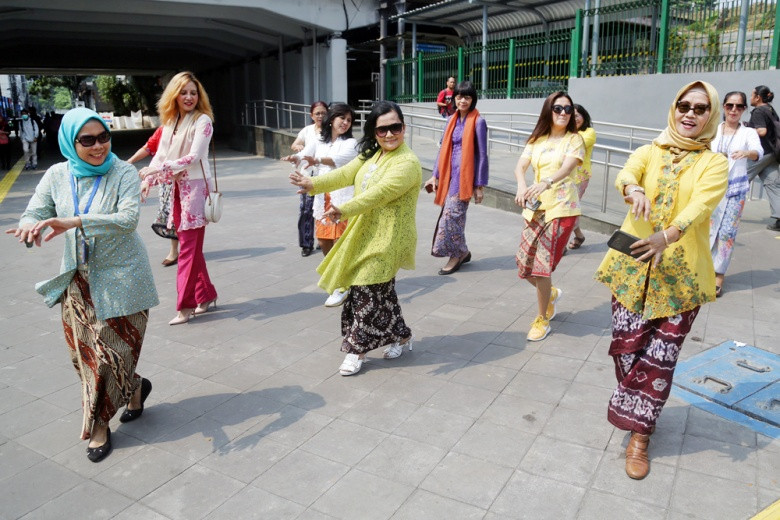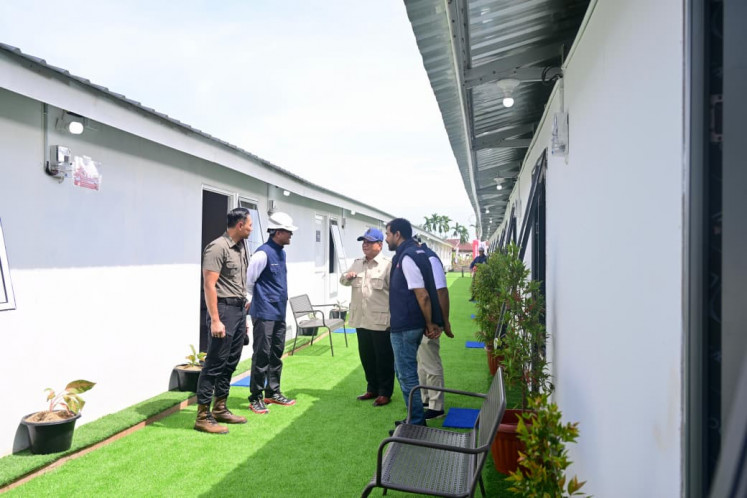Popular Reads
Top Results
Can't find what you're looking for?
View all search resultsPopular Reads
Top Results
Can't find what you're looking for?
View all search results‘Kebaya’ vs hijab: Questioning Indonesian identity
The “war” between jilbab or Arabic-influenced clothing and kebaya risks the danger of making us forget that essentially it is women’s rights and freedom of expression that we have to fight for.
Change text size
Gift Premium Articles
to Anyone
 Dancing in style: Women grouped under the #SelasaBerkebaya (KebayaTuesdays) movement dance at the Dukuh Atas MRT station in Jakarta on June 25, 2019. The movement considers the traditional blouse a part of Indonesian identity and encourages it to be worn for regular activities, not just parties and official occasions. (JP/Wendra Ajistyatama)
Dancing in style: Women grouped under the #SelasaBerkebaya (KebayaTuesdays) movement dance at the Dukuh Atas MRT station in Jakarta on June 25, 2019. The movement considers the traditional blouse a part of Indonesian identity and encourages it to be worn for regular activities, not just parties and official occasions. (JP/Wendra Ajistyatama)
O
n Thursday, Yogyakarta hosted a Kebaya Festival, reportedly involving 2,020 women. It follows limited displays of women deliberately wearing kebaya (traditional blouse) in their daily activities, to assert their Indonesian identity, including many who voluntarily wear the hijab.
The trend of wearing hijab or jilbab in Indonesia most probably started to become more visible around mid-1990s, soon after the regulation that allows students to wear religious clothing was issued on Feb. 16, 1991. Earlier relatively few wore it following the influence of Iran’s Islamic Revolution. Before this, although there was no formal ban on the jilbab (headscarf), the government 1982 regulation stated there should be stricter standards on national school uniforms, leading school authorities to ban the jilbab. Several students, such as in Jember, East Java, were threatened or even expelled if they refused to take off their jilbab. Some friends of mine were threatened with expulsion from school, not for wearing the jilbab but for wearing skirts considered too short.
Indeed, different clothing regulations have often targeted women and made them the victims as well. It was only female students, not males, who were affected by New Order era regulations on uniforms. Now, the jilbab trend has been attracting various responses. Around 2012, women were chastised for wearing jilboobs – a derogatory term against women considered keen on showing off their “boobs” while wearing jilbab, and earned condemnation from the Indonesian Ulema Council (MUI). Men wearing tight jeans, tight shirts or even no shirt, can do this free of scolding. But women’s clothing has continually been the focus of talks and scrutiny, even parts of their bodies have to be discussed and if necessary restricted by men.
Restriction usually correlates with punishment. Thus, although various religious organizations have claimed that wearing jilbab is not a must for Muslim women, there have been reports that school children have been coerced to wear jilbab and that some students who refused to wear jilbab had been bullied. A few celebrities including “Rina Nose” who decided to take off her jilbab after about one year of wearing it, was widely criticized for her decision.
Many who disagree with the jilbab trend in Indonesia view this trend as a form of repression and believe there have been cases when women are either pressured into wearing this form of clothing. Despite many women adopting it voluntarily out of religious belief, there have also been concerns that jilbab has eroded the national identity of Indonesia, with the import of Arabic culture. Such women promote the wearing of sanggul or traditional bun and kebaya for women instead of covering the head and torso with long jilbab.
The slogans of “Kebaya is truly Indonesian”, “Kebaya is the real Indonesian identity” and “Let’s wear kebaya every day” have spread on social media. There is even a suggestion of an official Kebaya Day, with Yogyakarta hosting the Festival Kebaya on Feb. 20 with 2,020 women. Pictures of women with kebaya are placed side by side with women in jilbab and Arabic-influenced clothing with a question underneath: Which one is more beautiful?
The irony is that the types of kebaya promoted recently on the Indonesian media are mainly known as Javanese and Malay kebaya. Moreover, according to historian Denys Lombard, kebaya started being worn by people in several southeast islands before the current archipelago was even known as Indonesia, only from about the 15th or the 16th century. Before then, most women and men wore a piece of cloth like sarong and walked around bare-chested. Some elderly Balinese women in villages still wear this form of clothing. To claim that kebaya as a symbol of Indonesian identity can also be misleading if we consider that people in several eastern parts of Indonesia, like Papua, do not wear such “traditional” clothing. People in Papua are even still being mocked by those from other parts of Indonesia because their clothing is considered too revealing and “primitive”. So what makes kebaya a symbol of Indonesian national identity then?
















